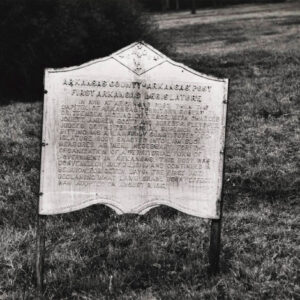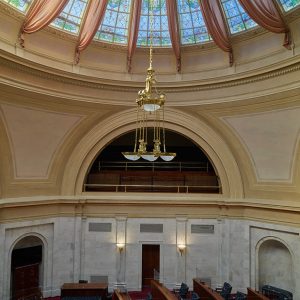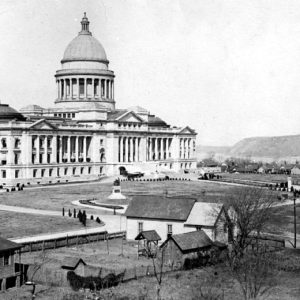calsfoundation@cals.org
Arkansas General Assembly
aka: State Legislature
aka: Arkansas State Legislature
aka: General Assembly
aka: Arkansas House of Representatives
aka: Arkansas Senate
aka: Arkansas Legislature
The Arkansas General Assembly is the legislative body governing the state of Arkansas. Since statehood in 1836, Arkansas has been governed by five constitutional charters. Under each charter, the composition and powers of the Arkansas General Assembly has changed. Since the adoption of the 1874 constitution, the most recent one, multiple amendments have altered the body’s operations as well.
According to the 1836 constitution, members of the state House of Representatives had to be at least twenty-five years of age, and members of the state Senate had to be thirty. Under this constitution, members had to be white males and had to have resided in the state for at least one year. The Arkansas General Assembly was to meet every two years on the first Monday in November, and elections were to be held every two years on the first Monday in October. While the governor, county officials, and members of the legislature were elected directly by the people, a joint session of the Arkansas General Assembly met and elected the state treasurer, secretary of state, auditor, and judges. Prior to the passage of the Seventeenth Amendment in 1913, the legislature also elected U.S. senators. When Arkansas, upon seceding, enacted a new constitution in 1861, it differed little from the 1836 document. Following Union occupation of much of northern Arkansas, the 1864 constitution enacted under Presidential Reconstruction contained only minor changes as well.
With the implementation of the Reconstruction Acts, commonly referred to as Congressional Reconstruction, Arkansas called a new constitutional convention; this convention drafted a radically different document than previous charters. Under the constitution of 1868, the Arkansas General Assembly met on the first Monday of January in odd-numbered years. Members of the state House of Representatives had to be at least twenty-one years of age, and their Senate counterparts had to be twenty-five. The state House had eighty-two members, while the state Senate had twenty-six. This Arkansas General Assembly, which controlled the state’s printing contracts, was required to meet in the open and maintain a journal of proceedings for each house.
In 1874, the voters of Arkansas approved a call for a new constitutional convention. This convention produced a document that in many ways was a Democratic Party response to the 1868 constitution, approved under Republican rule. Under the charter, members of the House of Representatives are elected every two years, senators every four years, and the body was called upon to meet every two years on the second Monday in November. The state’s legislative districts were to be reapportioned following the census every ten years but did not have to contain equal populations. Following the U.S. Supreme Court’s 1962 ruling in Baker v. Carr and the proceeding ruling in Reynolds v. Simms (1964), this changed, and legislative districts had to contain roughly equal populations. Amendment 23 created the Board of Apportionment; Section 2 of this amendment set the number of House members at 100, and Section 3 set the number of senators at thirty-five.
The Speaker of the House is the leader of the lower chamber, and the state Senate is chaired by the lieutenant governor, who is not a member of the Senate but can cast a tie-breaking vote; in his absence, the Senate is chaired by the president pro tempore (pro tem). Both the speaker and the president pro tem are elected by the membership. Subsequent legislation has altered this meeting date to be the second Monday in January of odd-numbered years. In 2008, voters approved Amendment 86 to the state constitution mandating a yearly legislative session. Fiscal sessions are to meet in even-numbered years, while the regular legislative session continues to meet in January of odd-numbered years. Unlike the U.S. Congress, where all revenue bills must originate in the House of Representatives, in Arkansas, revenue bills may originate in either house. No bills may be introduced in the last three days of the session, though this does not apply to a special session called by the governor.
Due to the part-time nature of the Arkansas legislature and the growing demands on the legislature, the Arkansas Legislative Council was established by Act 264 in 1949. This joint committee of twenty House members and sixteen Senate members, as well as twenty-four ex-officio voting members and five ex-officio non-voting members, meets in the interim between sessions. It oversees the Bureau of Legislative Research, coordinates other interim committees, and provides legislative oversight in the interim.
In 1992, Amendment 73, which imposed term limits on state elected officials, was approved by approximately sixty percent of the Arkansas electorate. The amendment declared that all constitutional officers would be limited to two four-year terms. In addition, members of the state House of Representatives were limited to no more than three two-year terms, while members of the Senate were limited to two four-year terms. In actuality, due to reapportionment, many members of the state Senate were eligible to serve ten years. While the amendment sought to limit the terms of Arkansas’s congressional delegation, this was later found unconstitutional in the 1995 case of U.S. Term Limits, Inc. vs. Thornton. During the 2014 general election, Arkansas voters modified the term-limit provisions by the passage of Issue 3. While the legislation bans lobbyist gifts to state officials, prohibits direct corporate and union contributions to candidates, and lengthens the amount of time before a former lawmaker can become a lobbyist, it also increased the maximum number of years of service allowed in both houses of the Arkansas General Assembly to a total of sixteen years through any combination of House and Senate service.
For the 2022 election, the Arkansas General Assembly put before voters a ballot measure that would have allowed the legislature to call itself into extraordinary sessions, upon approval by at least two-thirds of its members, and to set the agenda for those sessions; this power has resided exclusively with the governor. However, this ballot measure was soundly defeated by voters on November 8, 2022.
For additional information:
Arkansas State Legislature. http://www.arkleg.state.ar.us (accessed January 25, 2024).
Branam, Chris W. “‘The African Have Taken Arkansas’: Political Activities of African Americans in the Reconstruction Legislature.” Arkansas Historical Quarterly 73 (Autumn 2014): 233–267.
Blair, Diane, and Jay Barth. Arkansas Politics and Government. 2nd ed. Lincoln: University of Nebraska Press, 2005.
Goss, Kay C. The Arkansas State Constitution: A Reference Guide. Westport, CT: Greenwood Press, 1993.
Gross, Matthew T. “‘Coupling’ Policy Agenda Research and Legislative Institutions: An Exploratory Analysis of State House Speaker Power and Punctuated-Equilibrium.” Midsouth Political Science Review 19 (2018): 25–50.
Hinshaw, Jerry E. Call the Roll: The First 150 Years of the Arkansas Legislature. Little Rock: Rose Publishing, 1986.
Lancaster, Bill. Inside the Arkansas Legislature. Bloomington, IN: Xlibris, 2015.
Miller, Mary Cooper. “Who Were These Elected Officials?” Izard County Historian 45 (October 2020): 7–33.
Parry, Janine A., and William Miller. “African Americans in the Arkansas General Assembly: 1972–1999.” In Politics in the New South: Representation of African Americans in Southern State Legislatures, edited by Charles E. Menifield and Stephen D. Shaffer. Albany: State University of New York Press, 2005.
———. “‘The Great Negro State of the Country?’: Black Legislators in Arkansas, 1973–2000.” Journal of Black Studies 36 (July 2006): 833–972.
Riva, Sarah. “Acting Up and Courting Controversy: The Arkansas General Assembly Legislative Sessions of 1957, 1958, and 1959.” MA thesis, University of Arkansas at Little Rock, 2013.
Smith, Lindsey Armstrong, and Stephen A. Smith. Stateswomen: A Centennial History of Arkansas Women Legislators, 1922–2022. Fayetteville: University of Arkansas Press, 2022.
Whistler, Donald E. Citizen Legislature: The Arkansas General Assembly. Indianapolis, IN: Western Newspaper Publishing Company, 2010.
Wintory, Blake. “African American Legislators in the Arkansas General Assembly, 1868–1893: Another Look.” In A Confused and Confusing Affair: Arkansas and Reconstruction, edited by Mark K. Christ. Little Rock: Butler Center Books, 2018.
Rodney Harris
Fayetteville, Arkansas
 African American Legislators (Nineteenth Century)
African American Legislators (Nineteenth Century) Alford, Boyce
Alford, Boyce Arkansas State Capitol Building
Arkansas State Capitol Building Chambers, Erle Rutherford
Chambers, Erle Rutherford Foster, William Franklin (Bill)
Foster, William Franklin (Bill) General Improvement Fund
General Improvement Fund Gwatney, William Alan (Bill)
Gwatney, William Alan (Bill) Jones, Green Hill
Jones, Green Hill Jones, Myra
Jones, Myra Law
Law Mahony, Joseph Kirby "Jodie"
Mahony, Joseph Kirby "Jodie" Mays, Richard Leon
Mays, Richard Leon Politics and Government
Politics and Government Revenue Stabilization Act
Revenue Stabilization Act Rutherford, James
Rutherford, James Arkansas General Assembly, 1909
Arkansas General Assembly, 1909  Arkansas Post First Legislature Marker
Arkansas Post First Legislature Marker  House Chamber
House Chamber  Max Howell
Max Howell  Hunt and Chambers
Hunt and Chambers  State Capitol Building
State Capitol Building  Townsend and Assembly Members
Townsend and Assembly Members 




Comments
No comments on this entry yet.